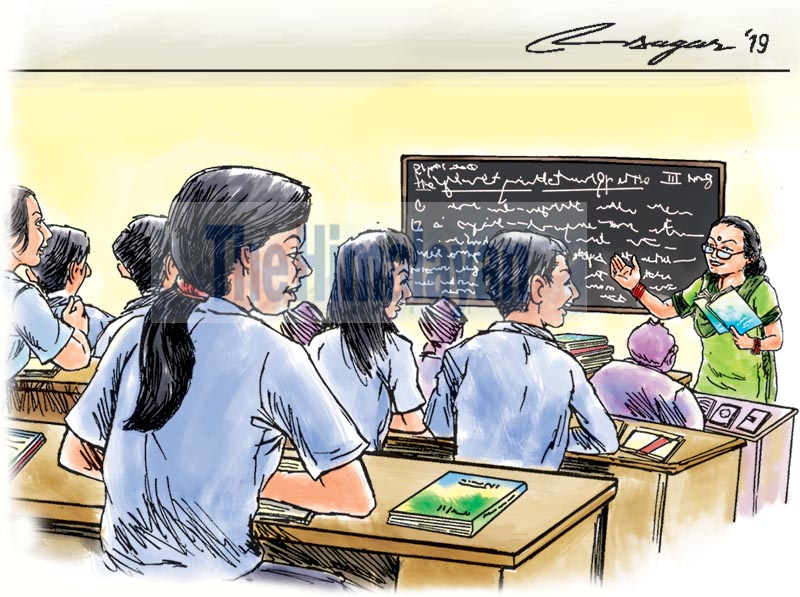Continuous assessment: Fundamental to pedagogy
Modern day assessment expects teachers to continuously assess their students to have an idea of what has been learnt and consequently inform the teachers if their teaching approach needs to be modified
Assessment is generally understood as the process of evaluating or gauging the students’ level of attainment. In order to ascertain how much of learning has taken place, assessment is cardinal to pedagogy. J M Green in her speech delivered in 1998 entitled ‘Constructing the way forward for all students’ maintained that the implication of the word ‘assess’ is something we ‘do with and for’ students as opposed to something that is ‘done’ to the students.
Conventionally, around the world, Nepal being no exception, assessment is thought of simply as an examination taken at the end of a unit. Terminal examinations and final examinations are considered more than sufficient to give a clear picture of students’ understanding. However, such one-off assessment modality has increasingly begun to come under question nowadays with the understanding of assessment as a phase-wise and continuous process gaining force.
Assessment is integral to all teaching and learning. The modern-day assessment system expects teachers to continuously assess their students for twin purposes: to have a timely idea of how much of what has been delivered has actually been grasped by the students and consequently to inform the teachers if anything needs to be modified regarding their teaching approach. The success of continuous assessment depends very much on factors like class size, teacher training and a school’s resources. In sharp contrast to what has been generally held about assessment, it begins right at the beginning even before the teacher starts a new unit. This phase is called the pre-assessment stage.
Most of the units fail to cater to majority of students in a classroom because the level of input the students receive is way beyond their current level of knowledge. On the flipside of it, the units fail also because sometimes what is taught is already known to the students, which they have no interest to learn. This phenomenon is backed by the input hypothesis under the Monitor model of linguistics professor Stephen Krashen. The importance of pre-assessment against this backdrop becomes all the more important. Pre-assessment, simply understood, is the assessment carried out at the beginning before the introduction of any unit to check the prior understanding of students.
Dr Victoria Berhardt, highlighting the importance of educational data in 1988, has posited that “Data helps us to understand where we are right now, where we want to go in the future, and what it is going to take to get there.” This data that Bernhardt is talking about can be obtained through pre-assessment.
Formative assessment is anything and everything that teachers do to help students attain the learning goals by providing timely feedback, tailored assistance and support. It is for this very reason that it is also called ‘assessment for learning’. Shirley Clarke, an assessment consultant and teacher trainer, offered ‘a garden analogy’ in 2001, which is very instructive in understanding what formative assessment is.
Imagine a farmer and the plants in his garden. His plants will surely die out and wither if his task is limited to just planting them and expecting nature to take care of them. In order to ensure that they grow well, he needs to constantly monitor, feed and water those plants. Formative assessment is the equivalent of feeding and watering the plants appropriately to their needs - directly affecting their growth. Frequent monitoring of each student’s learning is essential for effective teaching.
No teacher should be allowed to assign responsibility for it to others.
While formative assessment is done while the unit is ongoing, summative assessment, also understood as ‘assessment of learning’, is carried out at the end of the unit. This type of assessment is the most traditional way of evaluating a student’s work and is taken by the students at the end of a unit or semester to demonstrate the sum of what they have or have not learned.
Again, a garden analogy would be quite useful in understanding what summative assessment is. Summative assessment of the plants is the process of simply measuring them. It might be interesting to compare and analyse measurements but, in themselves, these do not affect the growth of the plants. This, by its very nature, can run into problems as it measures only the end results and is simply an act of measuring in sharp contrast with formative assessment which aids and abets the growth as well.
As per the traditional reporting system, summative assessments are given out in a piece of paper called report cards, where students’ grades are given largely based on the written examinations taken over a certain period of time. This system of marking, grading and averaging often demoralises students and lowers their self-esteem.
Advice and improvements are barely given, and even if they are, it becomes too late for students to rectify things. Ken O’ Connor, an independent consultant on grading and assessment, in 2002 offered mitigating measures to such a flawed system of reporting, which include basing grades and reports on clearly specified learning goals and performance standards, using valid evidence and established criteria for grading, avoiding grading based on averages and also reporting the achievement of students and other factors separately.






